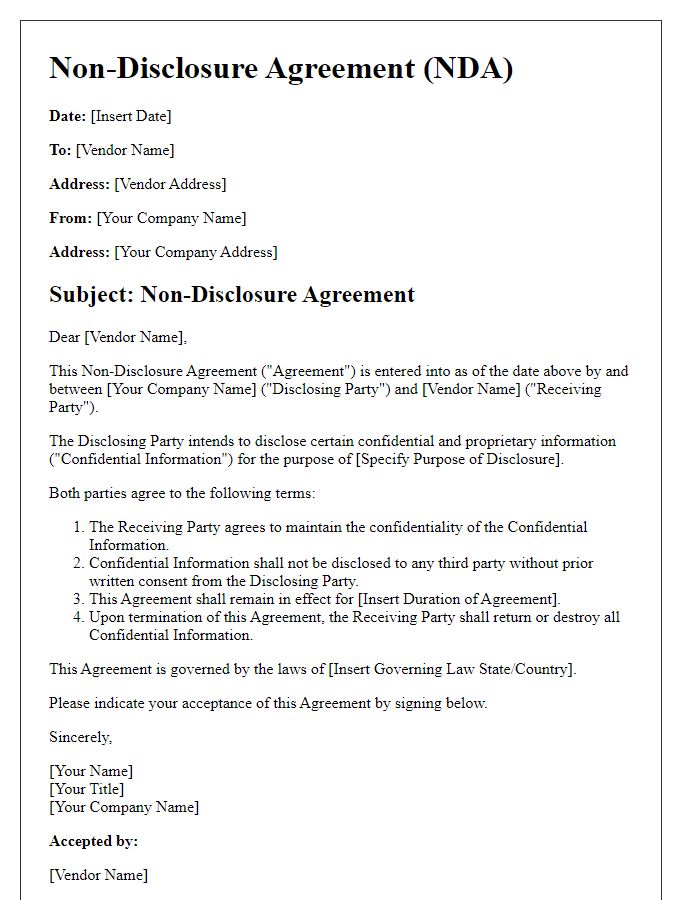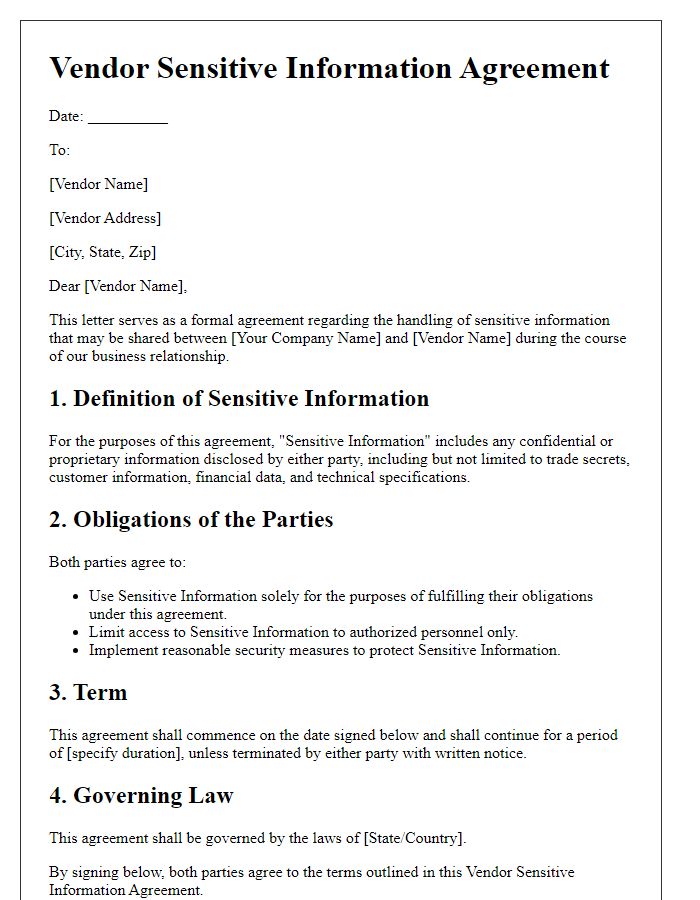Are you considering entering into a vendor non-disclosure agreement (NDA), but unsure of where to start? Crafting an effective NDA can seem daunting, but it's essential for protecting your sensitive information in business relationships. From defining confidential information to outlining the duration of the agreement, each detail plays a crucial role in safeguarding your interests. Join us as we delve into the key components of an effective vendor NDA, ensuring you're well-equipped to create one that serves your needs.

Confidential Information Definition
A comprehensive definition of confidential information is crucial for a vendor non-disclosure agreement (NDA). Confidential information typically includes proprietary data, trade secrets, financial details, customer lists, marketing strategies, and product designs originating from the disclosing party. For instance, sensitive information may involve specific sales figures exceeding $1 million or intellectual property relating to software development projects, such as source code or algorithms. Additionally, confidential information can encompass any oral, written, or electronic data exchanged between the parties, which is explicitly marked as confidential. The NDA should clearly outline the scope, duration, and obligations surrounding the protection of this information to prevent unauthorized disclosure and ensure compliance with legal standards.
Obligations and Responsibilities
The vendor non-disclosure agreement (NDA) outlines critical obligations and responsibilities regarding the protection of confidential information. Vendors must ensure the secure handling of proprietary data, including trade secrets and business strategies, received during collaborations. Compliance with confidentiality terms extends to all employees and subcontractors involved (a legal category that may include freelancers) and mandates that any disclosed information is only used for purposes specified within the agreement. Additionally, vendors are expected to implement robust security measures, such as encryption and access controls, to prevent unauthorized disclosure or breaches. Violations of these obligations may result in legal consequences, including financial penalties or damage claims, emphasizing the importance of adherence to the NDA's provisions.
Exclusions from Confidential Information
In non-disclosure agreements (NDAs), exclusions from confidential information play a crucial role in defining the boundaries of what information remains protected. Standard exclusions typically include information that is already publicly available, knowledge that the receiving party can prove was known prior to the agreement's execution, and material independently developed by the receiving party without reference to the confidential information. Additionally, disclosures required by law or court order may also be excluded to ensure compliance with legal obligations. Understanding these nuances aids in clearly outlining the scope of confidentiality and protecting intellectual property while allowing for necessary transparency in business operations.
Term and Termination
A non-disclosure agreement (NDA) is crucial for protecting sensitive information exchanged between parties, particularly in vendor relationships. The term of the NDA typically spans three years, starting from the effective date, ensuring confidentiality during and after the engagement. Termination clauses allow either party to end the agreement with a written notice of 30 days, preventing future obligations regarding disclosed information. Certain conditions, such as mutual consent or breach of terms, can also trigger immediate termination. The provisions regarding the duration of confidentiality obligations often extend beyond termination, maintaining protection for proprietary information, trade secrets, and other sensitive data indefinitely or for a specified time frame, depending on the nature of the information.
Dispute Resolution and Governing Law
In vendor non-disclosure agreements, the dispute resolution clause outlines the process for resolving any conflicts that arise, emphasizing the importance of mediation or arbitration as preferred methods. Mediation facilitates a collaborative environment for both parties to negotiate a settlement, while arbitration involves a neutral third-party arbitrator making a binding decision. The governing law determines which jurisdiction's laws will be applied in the agreement, ensuring both parties understand their legal framework, such as the laws of the State of New York (known for its business-friendly environment) or California (with a focus on technology and intellectual property). This section is crucial for creating clarity in legal proceedings, defining terms and expectations for both parties involved in the agreement to ensure compliance and protection of sensitive information.













Comments